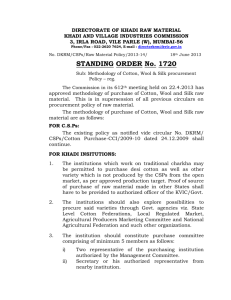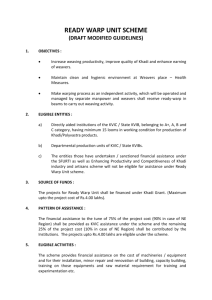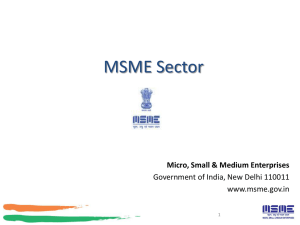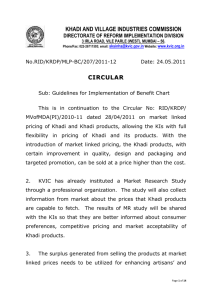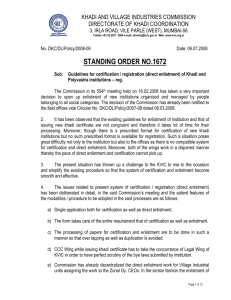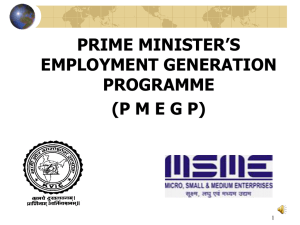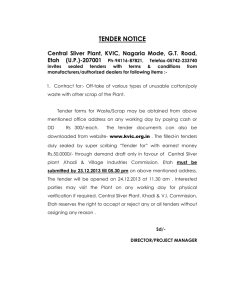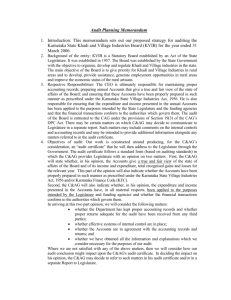Reviving Khadi in India
advertisement
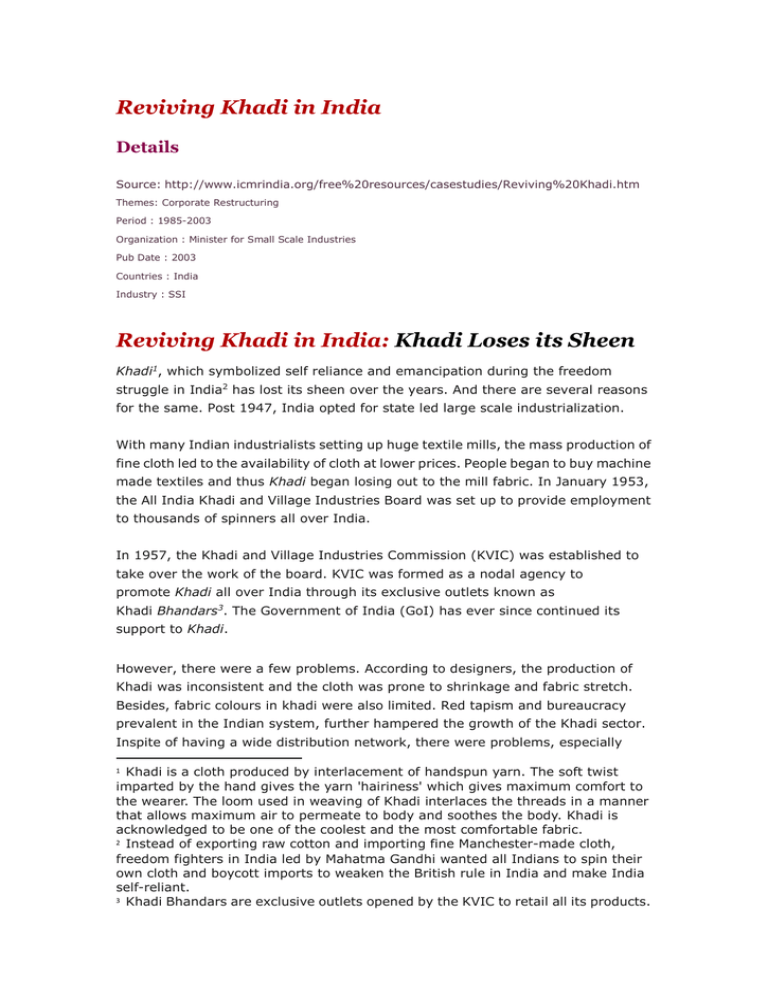
Reviving Khadi in India Details Source: http://www.icmrindia.org/free%20resources/casestudies/Reviving%20Khadi.htm Themes: Corporate Restructuring Period : 1985-2003 Organization : Minister for Small Scale Industries Pub Date : 2003 Countries : India Industry : SSI Reviving Khadi in India: Khadi Loses its Sheen Khadi1, which symbolized self reliance and emancipation during the freedom struggle in India2 has lost its sheen over the years. And there are several reasons for the same. Post 1947, India opted for state led large scale industrialization. With many Indian industrialists setting up huge textile mills, the mass production of fine cloth led to the availability of cloth at lower prices. People began to buy machine made textiles and thus Khadi began losing out to the mill fabric. In January 1953, the All India Khadi and Village Industries Board was set up to provide employment to thousands of spinners all over India. In 1957, the Khadi and Village Industries Commission (KVIC) was established to take over the work of the board. KVIC was formed as a nodal agency to promote Khadi all over India through its exclusive outlets known as Khadi Bhandars3. The Government of India (GoI) has ever since continued its support to Khadi. However, there were a few problems. According to designers, the production of Khadi was inconsistent and the cloth was prone to shrinkage and fabric stretch. Besides, fabric colours in khadi were also limited. Red tapism and bureaucracy prevalent in the Indian system, further hampered the growth of the Khadi sector. Inspite of having a wide distribution network, there were problems, especially Khadi is a cloth produced by interlacement of handspun yarn. The soft twist imparted by the hand gives the yarn 'hairiness' which gives maximum comfort to the wearer. The loom used in weaving of Khadi interlaces the threads in a manner that allows maximum air to permeate to body and soothes the body. Khadi is acknowledged to be one of the coolest and the most comfortable fabric. 2 Instead of exporting raw cotton and importing fine Manchester-made cloth, freedom fighters in India led by Mahatma Gandhi wanted all Indians to spin their own cloth and boycott imports to weaken the British rule in India and make India self-reliant. 3 Khadi Bhandars are exclusive outlets opened by the KVIC to retail all its products. 1 middleman. Corruption was rampant. There were many bogus Khadi units operating in the country, which made it extremely difficult to claim rebates from the Government of India (GoI). KVIC received huge financial assistance from the GoI in the form of subsidies and rebates. In May 2000, the Ministry of Small Scale Industries, announced a special package of Rs.12.16 billion to the industry. In order to face the challenges of globalization and strengthen its position in the market, KVIC launched two separate brands, Sarvodaya and Khadi in August 2001. Sarvodaya comprised consumer goods like incense sticks, spices, honey, and pickles. The Khadi brand included products like essential oils, herbal oil & soaps, face scrubs, dry fruit honey, designer garments etc. The Khadi brand was introduced exclusively for exports and upmarket. The fabric was being promoted as a fashion fabric. Many high profile fashion designers were roped in to create garments using the fabric. KVIC allotted huge funds into research and development to improve the quality of Khadi. It allotted around Rs. 0.4 billion for promoting the fabric emphasizing its Unique Selling Proposition (USP), eco-friendliness. Background Note Khadi has its roots in the freedom struggle of India. Khadi, the home spun cloth was central to Gandhi's vision of self- reliance and self- rule. Gandhi wanted Indians to spin their own cotton thread and to weave Khadi, thereby, providing employment to many Indians and contributing to the country's self-sufficiency. Post independence, Khadi fabrics were woven on handlooms from cotton, silk, and woollen yarn, which were hand-spun. The production of Khadi is labour intensive as the weaving has to be done manually. The pure cotton collected from cotton farms is first ginned and bales are made. These bales are then converted into rowings and distributed to different spinning units. In the spinning units, the cotton fibre is manually converted into yarn using charkas.4 The yarn is then woven into fabric using handlooms. During the post-independence era, Indian industrialists set up capital intensive textile mills. Due to mass production, these mills could offer fine cloth at lower prices. Synthetic material like polyester was available at a very low price compared to Khadi. Thus despite all policy incentives to popularize Khadi, people bought machine made textiles. In order to popularize khadi among the masses, in 1957, the government set up the KVIC. It had the following broad objectives: 4 Charka is the Indian version of the spinning wheel. - The social objective of providing employment - The economic objective of producing saleable articles, and - The wider objective of creating self-reliance amongst the poor and developing a strong rural community spirit. Besides Khadi, KVIC also dealt with other products such as toilet soaps, detergents, honey, pickles, spices, incense sticks, handmade paper, leather, ceramics, and many other agro-based products (Refer Exhibit 1 for product range of KVIC). To keep the spirit of Khadi alive and promote it as a national fabric, KVIC has set up many outlets across India. As a result thousands of spinners, who wove the fabric could sell their output through the vast network of KVIC retail outlets. However, the situation did not improve much. The poor quality of garments sold through the KVIC outlets, resulted in customers' dissatisfaction. People even complained that the quality of Khadi had deteriorated and hence it faded easily. In the 1990s, very few people bought Khadi. Khadi was bought only during the annual discount sale. Synthetic material was quickly replacing the hand made fabric. People who had got used to the high quality of imported materials, felt that coarse and associated it with shapeless kurtas,5 Khadi was rough and mostly worn by politicians. And therefore, in spite of the GoI's financial assistance to thousands of traditional spinners in India, they had tough time selling their product. Reviving Khadi: From Freedom Fabric to Fashion Fabric In 1985, designer Devika Bhojwani pioneered the Swadeshi label of Khadiensembles. Those were distributed through nearly 5000 Khadi Emporia. To display Khadi's potential, KVIC organized a fashion show in Mumbai in 1989. Nearly 85 dazzling garments created by Devika Bhojwani were presented at the show. This was the first step towards changing Khadi's earlier image of being unfashionable. Commenting on the poor state of Khadi, Devika Bhojwani said that failures in the Khadi sector were a result of red tapism and bureaucracy prevalent in the Indian system. Even though the country had a wide distribution network, the middlemen, commissions and cuts had gradually weakened the system. She further said that though the government was taking the initiative to revive Khadi, nothing much would improve until the implementation, and the cost per garment etc. were controlled. In 1990, the Delhi based designer, Ritu Kumar presented her first Khadi collection, Tree of Life, which helped put Khadi in the fashion circuit. With increasing interest of 5 Kurta is a loose fitting shirt. the western world in use of handloom and Khadi, many Indian designers began to use Khadi for their designs. The government also made efforts to promote Khadi. In September 2000, Vasundhara Raje, Minister for Small Scale Industries, initiated a movement to revive all the 7,000 KVIC shops in India and make Khadi more fashionable and affordable. The KVIC Board hired the services of leading fashion designers to help create a new range and brand of Khadi wear. In May 2001, KVIC set up the first air-conditioned shop in New Delhi. The décor was modern and the clothes were neat and fashionable. The outlet sold Khadi garments designed by high profile designers. On the opening of this outlet, well-known fashion designer, Rohit Bal commented, "Khadi is the Indian alternative for linen. It is as comfortable and now, we've proved that it is as fashionable"6. In January 2002, a high-profile textile exhibition, featuring Khadi ensembles designed by prominent Indian designers, was launched in New Delhi to popularise the traditional hand-spun cotton. The idea of the exhibition was to promote wholly hand spun, hand woven and hand patterned fabric, as a unique luxury product. The exhibition displayed western as well as traditional Indian attire made from the finest Khadi available in the country. Besides, nearly 110 varieties of the fabric (from the sheerest to the coarsest) were showcased. Designer Rakesh Thakore, whose collection was showcased in the exhibition commented, "If packaged well, Khadi can be sold internationally."7The exhibition was sponsored by a Swiss charitable trust, Volkart Foundation 8 in association with the Indian National Trust for Art and Cultural Heritage (INTACH).9 With many designers experimenting with Khadi, the designs are no longer as simple as they used to be. A great deal of emphasis was given to the details of the designs and many new colours were introduced. Eco-friendly vat dyes were used. In March 2002, Preyasi 10 , the official designer for KVIC, launched "The Khadi Range Sengupta, Hindol, Khadi-Much More than a Fabric, Indo-Asian -News –Service. 'Glamour platform for Gandhian cotton,' news.bbc.co.uk , Wednesday, January 30, 2002. 8 Volkart Foundation, a Swiss charitable trust, is devoted to funding sustainable development. Marking its 150th anniversary, in February 2001, the Volkart Foundation pledged US $ 1 million as a cultural and social grant. The Khadi exhibition which formed a part of this, was meant for the revival of the old cotton business, Khadi as well as to highlight the non-violence movement. 9 INTACH is an NGO that seeks to make strategic and timely intervention in order to conserve and promote India's natural and cultural heritage. INTACH has a nation-wide network of volunteers, who spread awareness about heritage, prevent acts likely to degrade their region's cultural and natural wealth and act positively to preserve and enhance local heritage. INTACH is the nation's largest NGO working in the field of culture. 10 Preyasi is a certified designer by the Ministry of Handicrafts and Textiles - Govt. of India. It claims to be the world's best Wardrobe Management Company. Since fifteen years, Preyasi has been involved in delivering designer-wear and consultancy services to clients in over 48 countries. In 2001, it signed up with KVIC as their official designer to design and promote Khadi garments in the national and 6 7 Collection-2002." In the collection, Khadi was used to create apparel such as, casual shirts, waist coats, skirts, wrap-arounds, trousers, parallels, and tops for women. Government Support to Khadi The GoI had been providing huge subsidies and grants to the Khadi sector. Khadi was given a rebate11 of Rs. 1.49 billion and Rs. 1.4 billion in 1998-99 and 1999-2000 respectively. In 2000-2001, funds to the tune of Rs. 1.29 billion were released for the same. During the same time, concerted efforts were made to root out corruption in the payment of rebate. Regular vigilance raids were conducted in various parts of the country to detect malpractices in claiming of Khadi rebates and to distinguish between genuine and bogus Khadi and village industries. In May 2000, the Ministry of Small Scale Industries announced a special package of Rs.12.15 billion for KVIC. Of this, Rs.0.3 billion had been allocated for renovation of the existing outlets, while Rs 0.4 billion was sanctioned for promotional activities. Though the GoI provided huge financial assistance to KVIC, the funds did not produce the desired result. It was also being felt that the structure of KVIC needed to be changed to enable it to face the challenges of globalization. Therefore, in 2000, the global consulting firm, Arthur Anderson was hired to suggest restructuring strategies for KVIC. According to the report, submitted to the Ministry of Small Scale Industries, KVIC should be a policy-making body and play a strategic role rather than being involved in the operations. It also suggested that KVIC should be made a market-oriented organization, and given the freedom to decide on the issues of rebate. In order to improve the marketing and retailing aspects of the sector, it was proposed that an independent marketing company be formed, which would be disintegrated from the existing Khadi and village industries structure. This company would also deal with improvements in the quality of products, packaging and marketing. It also recommended that the special rebate on Khadi products be made available in the first week of every month, instead of the usual 90-day period after the month of October. The declining production, sales, rural employment opportunities and share of Khadi in the total business of KVIC had become a matter of serious concern for the government (Refer tables I, II and III). This had assumed greater significance as the population and per capita consumption of clothes in India had considerably increased over the years. Keeping this in view, the GoI took many initiatives to promote the sector and exploit the full international market. 11 These rebates are the discounts given by the Khadi outlets to the consumers, which can be later claimed back from the KVIC. potential of Khadi as a product category in all its forms. As a part of these initiatives, KVIC registered Khadi as a brand name, thereby, protecting it legally. In order to compete with other varieties of textile and make it more acceptable in the market, improvisation was needed and new products and designs had to be developed. Keeping this objective in mind, in October 2001, KVIC signed a memorandum of understanding with the Ahmedabad-based National Institute of Design (NID) to provide it design support in order to improve the diminishing market-share of Khadi. Under the agreement, a special cell would be set up at NID (financed by the KVIC) to provide design support services in Khadi, village industries, packaging, marketing, communication, publicity, disseminating materials and other design-related activities. Khadi Goes for a Facelift Over the years, the Khadi Boards of different states have been experimenting on blending of Khadi with other materials and improving its quality. In July 2002, a collection of ensembles in 'Tencel Khadi' (a blend of Tencel and Khadi in the ratio 30:70) was created by Bangalore-based designer, Deepika Govind, in association with the Karnataka Khadi Board. Tencel is a lyocell fiber natural in origin and hence, environment friendly. It offers the comfort and luxury of a natural fiber as well as the performance and practicality of a man-made fabric. Tencel Khadi showed lesser shrinkage (4-5%) as compared to the high shrinkage seen in Khadi garments (about 7 %). Due to Tencel's softness, it would become easier to work with Khadi and lend better drape quality to finished garments. Tencel Khadi would provide excellent scope for exports. In 2002, the Austria-based company, Lenzing AG, proposed to make Khadi more eco-friendly by blending the bio-degradable 'modal fibre'12 with Khadi. This blend would absorb 50 per cent more humidity than cotton. The blend, besides strengthening the Khadi yarn, would make it easy to wash and maintain. Future of Khadi The saleability of any textile depends on its USP and performance. For many years, the promotion for Khadi had been on emotional and political grounds while its quality and variety had been ignored completely. Khadi has very little to offer in terms of fabric performance. It looks attractive when starched and kept in showrooms but, it does not remain the same after washing. Even finer counts and blends of Khadi cannot withstand many washes and thus, cannot be used for day-to-day purposes. Modal is a speciality fibre, produced solely by the Austrian company, Lenzing AG. It is made exclusively from beechwood pulp and consists of 100 per cent cellulose. 12 It was becoming extremely difficult for Khadi to compete with the high-tech, colour-fast, wrinkle-free, mill-made cottons and blends available today. According to analysts, Khadi requires government sanction in every single activity and has therefore been stuck in a bureaucratic swamp, unable to increase its output or raise the quality of the fabric. In 2002, Khadi formed less than half per cent of India's textiles. In order to grow, the production of Khadi needs to be decentralized. A research and development wing should also be established by KVIC to experiment with new patterns and colours. Besides, weavers can also be given grants to enable creating new designs. KVIC must allot a special advertising budget to promote the fabric. KVIC plans to launch an advertising campaign in India and abroad to create awareness among people about Khadi and its uses. For this, it allocated an advertising and promotional budget of about Rs. 0.4 billion. It also plans to set up Khadi shops at all the international airports in India. KVIC is also exploring the possibilities of using e-commerce to market its products. However, Khadi, like any other craft of India, would need to face the challenge of quality and produce contemporary designs, which suit the tastes of the present generation.

